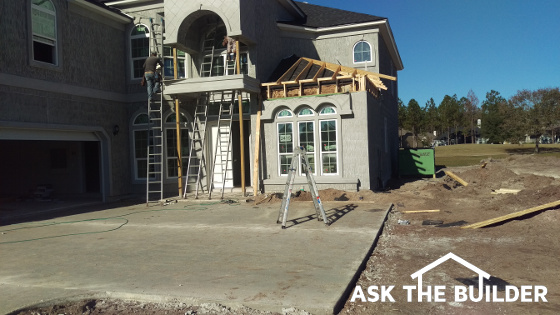New Home Hiccup

A mistake in roof height was caught very late in the job. Now it’s a nightmare. (C) Copyright 2017 Tim Carter
New Home Construction Hiccup
DEAR TIM: My builder really goofed up my new home. A room at the corner of the house next to the front door had its roof installed too low. The mistake is being corrected but I’m quite upset as I don’t feel the job is being done right. They’re leaving the old roof in place and putting the new framing on top of the old! Everyone is pointing fingers at who’s responsible. What I want to know is if this ever happened to you and how did you deal with it? Who’s ultimately responsible and how can mistakes like this be avoided? Cindy D., Breckenridge, CO
DEAR CINDY: Oh my goodness! I can’t believe what I see in the photo you sent. What a shame, especially since your new home is covered in stucco. It’s so hard to match stucco, but perhaps your plasterer will conjure up every bit of skill he possesses to make it look like nothing happened.
Let me share a similar story that happened to me late in my building career just before I transitioned to building with words and electrons instead of lumber, brick and copper.
I was working on the toughest job of my career at the time. For all intents and purposes I was building a small house onto an existing house in Cincinnati, Ohio. My appetite for more challenging jobs was insatiable.
Fortunately I had a fantastic set of blueprints and specifications to guide me. In a perfect world, and it only happened to me once in my twenty-plus years of building, the plans and specifications are so complete the builder never has to ask one question of the architect or homeowner. Everything the builder needs is on the plans.
This job was very complex. The old garage was to become the new enormous kitchen. A new two-car garage with separate garage doors was part of the new structure I was tasked to build.
The exterior of the giant room addition was used brick veneer that we expertly whitewashed to match the existing 70-year-old faded whitewash. The plans called for a gentle brick arch over each new garage door.
I built the arch frames for the bricklayer and installed them at the exact height as called for on the plans. My bricklayer installed the brick and they looked fantastic.
Within a day or two the homeowner complained the arches were too low. I was perplexed because I had triple checked my measurements. I went out and remeasured and the arches were right where the architect said to put them. Everything was done exactly per plan.
But the arches were too low, so low that if you tried to pull in the homeowner’s minivan the roof would scrape the right and left sides of the arch!
Who’s fault was it? I got blamed because, “You should have KNOWN when you set the forms they were too low!!!!” Let the finger-pointing games begin indeed!
My bricklayer and I worked together to raise the arches one foot to remedy the error. The cost was split three ways by me, the bricklayer and the architect. I’m still bitter about it because the architect should have absorbed the entire cost.
Who’s ultimately responsible for your mess? It’s a tough call and many attorneys have new fancy cars because people feel quite passionate about who should pay for these mistakes on new home jobs.
When you look at the contract documents, you might discover that you’re responsible. You might have signed a contract that says you’ll pay the builder XXX dollars to build what’s on the plans and in the specs. If the plans show it the way he first built it, he did what he was supposed to.
If the plans show it at the correct height and the framers made the walls too low, that’s an easy call. The builder has to absorb the cost as he’s ultimately responsible for field checking all work to ensure it matches what’s on the plans and in the specifications.
However, it ultimately comes down to you. You can’t hope everything is going to go right on your job. You need to check, recheck and check again all work as it happens. Is this hard? Yes. Will you avoid giant mistakes like you’re facing if you get out a tape measure every few days? You bet you will.